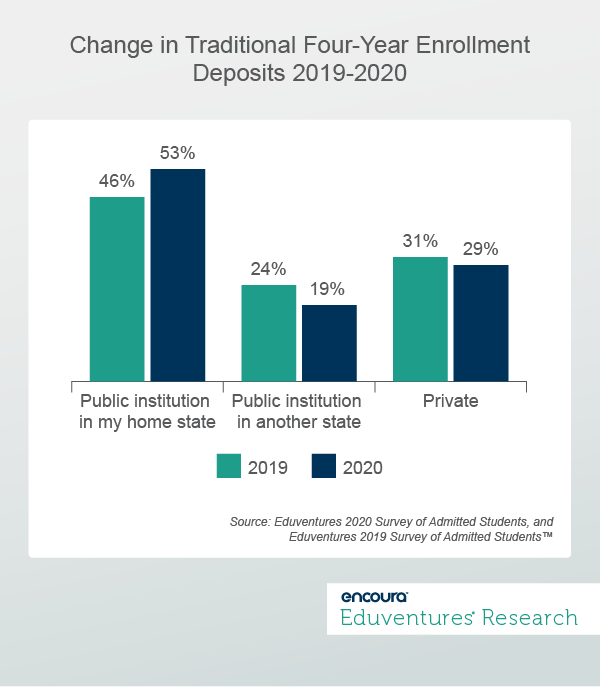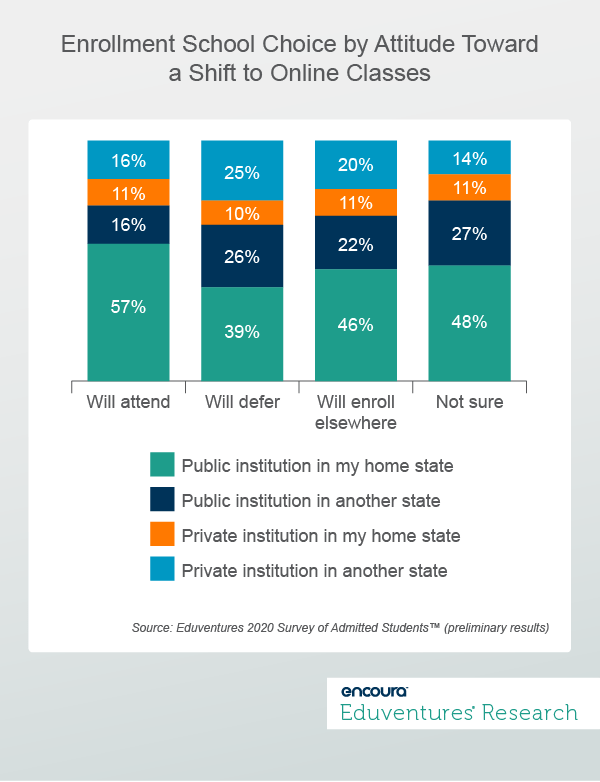The fall 2020 recruitment cycle has been the most difficult in recent history. Mid-cycle, recruiters found themselves reinventing their engagement strategies on the fly with little precedent or data to go on. Now that we are a short few weeks—or even days—away from the start of class, deposits provide the best picture we have of whether institutions are meeting enrollment goals.
But as COVID-19 cases soar and schools reconsider plans for on-campus instruction, will incoming freshmen decide to attend virtually? Or will they defer or choose a different school altogether, causing a scramble to secure a class admissions officers thought they had finished recruiting?
In June, Eduventures’ 2020 Survey of Admitted Students™ asked
From Pandemic to Pandemonium?
Before we dive into how an online fall might play into last-minute student decisions, let’s first examine what these plans are—at least as of June 2020. How are student enrollment plans different from pre-COVID times? Figure 1 compares enrollment patterns in 2020 to those from 2019. All students in both samples had been admitted by at least one four-year institution.

This comparison shows a significantly stronger preference for in-state public schools in 2020 (53% vs. 46% in 2019). Interest in private education is more stable but slightly down (by 3% overall), but preference for out-of-state public schools dropped from 24% in 2019 to 19% in 2020. Additionally, 20% of 2020 respondents said they are now more likely to attend an in-state public institution because of COVID-19, and 16% reported they are less likely to attend an out-of-state public institution.
Only 1% (each) said that they would take a gap year, work, or defer their enrollments, and just 1% of students said the pandemic made them more likely to pursue an online education. But, what happens if online delivery of classes is not a choice but rather the only available option?
No Campus, No Students?
“If the college you will be attending was temporarily moving its courses online due to a current or future COVID-19 disruption, would you still attend in the fall of 2020?” This is the burning question we asked admitted students. The question does not account for hybrid formats and presumes a fully online course of study, albeit a temporary one. Figure 2 shows how students reacted to the hypothetical question.

The good news is that about two-thirds of students (66%) told us they would still attend their choices. The bad news is that about a third would not unequivocally commit to the choices they already made. In June, just 4% of admits said with certainty that they would choose another institution, nearly 10% said they may defer, and 21% weren’t sure what they would do. This means that many institutions deciding to move courses online should expect to see a portion of their fall classes melt, if they haven’t already.
Who are these students at risk for attrition?
Not Leaving My Comfort Zone
Proximity to home seems to be the key factor. Figure 3 shows that out-of-state publics and privates are at greatest risk.

This doesn’t bode well for out-of-state enrollment in the coming fall. If classes are online—so the reasoning appears to go—why leave home? Perhaps paying for remote education with the higher price tag of an out-of-state public or private school may not be worth it for many families. But is this driven by actual cost or the perception of value?
Demographic differences show it may be a bit of both. Students who say they will stick with their original, predominantly in-state public choices are more likely to be a member of an underserved minority group, a population that more often chooses these high-value schools in the first place. Those who would choose a different school more often report a household income below $100,000, supporting the hypothesis that families are skeptical that temporary remote education is worth their financial sacrifices.
Students who would choose to defer, on the other hand, are most likely to have two college-educated parents. This may signal stronger parental support to wait out the pandemic until a “real” college experience can be had. Or it could signal parental pressure not to go out-of-state, leaving students who may be excited about their choices less sure about what to do.
Indeed, even unsure students have still largely deposited at their first-choice schools. So have students who would defer and those who would still attend. This last student segment, however, describes lower influence of COVID-19 on their enrollment choices and greater confidence they made the right choices.
In contrast, those who say they will attend elsewhere appear to be less smitten with their school choices. They are most likely to have double deposited and made their choices in May or later, and are least likely to deposit at their first-choice schools. These students may have one foot out the door regardless of delivery format.
The Bottom Line
The coming fall semester may not be what many anticipated even a few weeks ago. The COVID-19 pandemic shows no signs of slowing, and schools must rightfully do what is necessary to protect their students, faculty, staff, and communities. Many are announcing last-minute pivots to online learning to an audience that historically very much values the on-campus experience. Instead of a nerve-wracking end, many institutions and students will experience continued uncertainty and turmoil. Despite all the hard work in the spring, the bond between students and their institutions will remain tenuous.
While a majority of students still plan to attend their chosen schools, even if they have to start remotely, an alarming number of others have at least left open the door for last-minute changes. This will add to melt far beyond the summer at institutions with large out-of-state populations and sizable proportions of students with lukewarm—rather than excited—feelings about the school. More than ever, admissions, student affairs, and other offices should work closely together to ensure a seamless transition for enrolled students.
This recruitment cycle is not over quite yet. While enrollment offices now turn their attention to the daunting task of recruiting the next class, many must also take extra steps to ensure retention in far-from-ideal learning environments—all while keeping one eye on a transfer market that is likely to take off once campuses get back to normal.
Never Miss Your Wake-Up Call
Learn more about our team of expert research analysts here.
Eduventures Senior Analyst at ACT | NRCCUA
Contact
Thursday, August 13, 2020 at 3PM ET/2PM CT
The annual CHLOE (Changing Landscape of Online Education) survey chronicles the evolution of online policies and practices in U.S. higher education, from the perspective of Chief Online Officers (COOs). The fifth CHLOE survey captures leadership reflections on the pandemic-induced emergency remote instruction in the spring: what happened, what worked, and implications for fall. The CHLOE 5 report is published amid a coronavirus spike that is persuading many colleges and universities to re-think their fall re-opening plans.
This webinar will distill lessons from the spring and, in conversation with a panel of online leaders, gauge early fall realities. Online infrastructure, experience and leadership played a pivotal role in enabling schools to see through the last academic year, but many leaders have been quick to draw a distinction between hastily assembled “remote instruction” and true online learning. As fall 2020 gets underway, and schools face a yet stiffer test, online leaders are stepping up once again. Robust, engaging, high quality remote learning, by whatever name and whether or not combined with a socially distanced campus, will define this one-of-a-kind semester.
